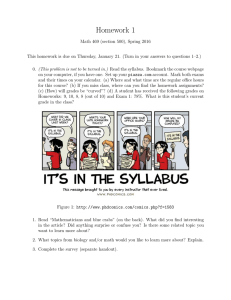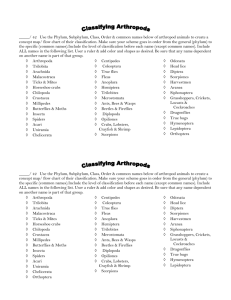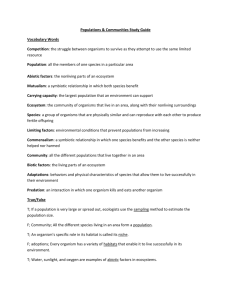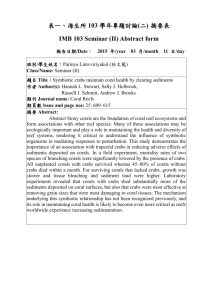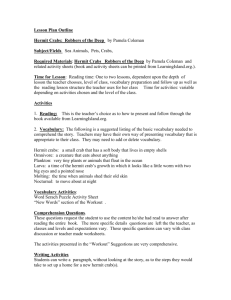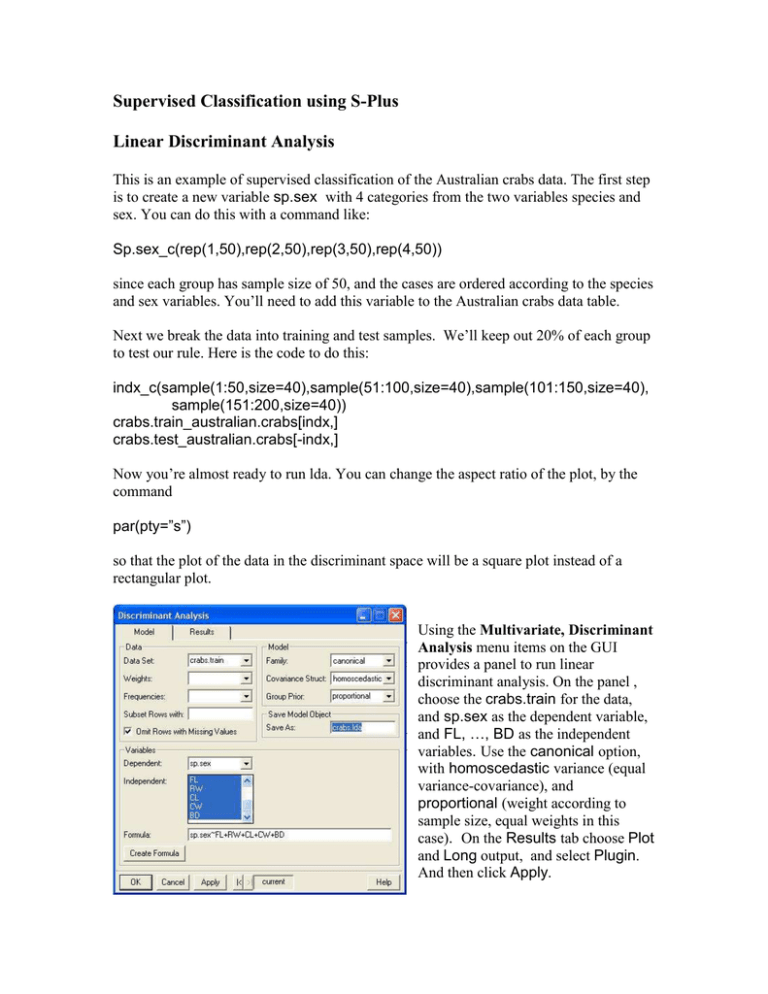
Supervised Classification using S-Plus
Linear Discriminant Analysis
This is an example of supervised classification of the Australian crabs data. The first step
is to create a new variable sp.sex with 4 categories from the two variables species and
sex. You can do this with a command like:
Sp.sex_c(rep(1,50),rep(2,50),rep(3,50),rep(4,50))
since each group has sample size of 50, and the cases are ordered according to the species
and sex variables. You’ll need to add this variable to the Australian crabs data table.
Next we break the data into training and test samples. We’ll keep out 20% of each group
to test our rule. Here is the code to do this:
indx_c(sample(1:50,size=40),sample(51:100,size=40),sample(101:150,size=40),
sample(151:200,size=40))
crabs.train_australian.crabs[indx,]
crabs.test_australian.crabs[-indx,]
Now you’re almost ready to run lda. You can change the aspect ratio of the plot, by the
command
par(pty=”s”)
so that the plot of the data in the discriminant space will be a square plot instead of a
rectangular plot.
Using the Multivariate, Discriminant
Analysis menu items on the GUI
provides a panel to run linear
discriminant analysis. On the panel ,
choose the crabs.train for the data,
and sp.sex as the dependent variable,
and FL, …, BD as the independent
variables. Use the canonical option,
with homoscedastic variance (equal
variance-covariance), and
proportional (weight according to
sample size, equal weights in this
case). On the Results tab choose Plot
and Long output, and select Plugin.
And then click Apply.
Here are the results:
*** Discriminant Analysis ***
Call:
discrim(structure(.Data = sp.sex ~ FL + RW + CL + CW + BD, class = "formula"),
data = crabs.train,
family = Canonical(cov.structure = "homoscedastic"), na.action = na.omit,
prior =
"proportional")
Group means:
FL
RW
G1 14.53 11.50
G2 13.34 12.18
G3 16.25 12.06
G4 17.36 14.59
CL
31.26
28.23
32.98
34.18
CW
35.93
32.78
36.41
38.50
BD
13.05
11.86
14.99
15.46
N Priors
40
0.25
40
0.25
40
0.25
40
0.25
Covariance Structure: homoscedastic
FL
RW
CL
CW
BD
FL 9.93 6.93 21.39 24.07 9.78
RW
5.19 15.13 17.05 6.90
CL
46.74 52.54 21.31
CW
59.22 23.96
BD
9.85
Canonical Coefficients:
dim1
dim2
dim3
FL 1.6105 0.3357 -1.8263
RW 0.5383 1.6172 0.5305
CL 0.3748 -1.2881 0.7397
CW -1.6470 0.7206 -0.6705
BD 1.2708 -0.4509 1.3253
Singular Values:
dim1 dim2 dim3
19.54 13.34 2.587
Constants:
G1
G2
G3
G4
-15.74 -25.3 -17.64 -40.29
Linear Coefficients:
G1
G2
G3
FL 6.464
7.55 13.55
RW 2.311
7.95
3.56
CL -7.641 -10.37 -3.53
CW 7.189
7.06 -3.05
BD -8.518 -7.45 -0.22
G4
17.22
10.48
-9.10
-0.87
-1.92
Canonical Correlations:
Canonical.Corr Likelihood.Ratio Chi.square df
Pr
dim1
0.9381
0.0240
576.1 15 0.0000
dim2
0.8797
0.2003
248.6 8 0.0000
dim3
0.3377
0.8860
18.8 3 0.0003
Eigenvalues:
Eigenvalue Difference Proportion Cumulative
dim1
7.341
3.919
0.6740
0.6740
dim2
3.423
3.294
0.3142
0.9882
dim3
0.129
0.0118
1.0000
Tests for Homogeneity of Covariances:
Statistic df Pr
Box.M
226.3 45 0
adj.M
213.4 45 0
Tests for the Equality of Means:
Group Variable: sp.sex
Statistics
F df1
Wilks Lambda
0.024 80.1 15
Pillai Trace
1.768 44.2 15
Hotelling-Lawley Trace
10.893 109.4 15
Roy Greatest Root
7.341 226.1
5
* Tests assume covariance homoscedasticity.
F Statistic for Roy's Greatest Root is an
df2 Pr
420 0
462 0
452 0
154 0
upper bound.
Hotelling's T Squared for Differences in Means Between Each Group:
F df1 df2 Pr
G1-G2 39.0
5 152 0
G1-G3 121.4
5 152 0
G1-G4 182.2
5 152 0
G2-G3 141.6
5 152 0
G2-G4 105.5
5 152 0
G3-G4 72.6
5 152 0
Plug-in classification table:
G1 G2 G3 G4 Error Posterior.Error
G1 36 4 0 0 0.10
0.1062
G2 2 38 0 0 0.05
0.0190
G3 0 0 40 0 0.00
-0.0360
G4 0 0 2 38 0.05
0.0685
Overall
0.05
0.0394
(from=rows,to=columns)
Rule Mean Square Error: 0.06431
(conditioned on the training data)
Cross-validation table:
G1 G2 G3 G4 Error Posterior.Error
G1 36 4 0 0 0.1000
0.1107
G2 2 38 0 0 0.0500
0.0213
G3 0 0 40 0 0.0000
-0.0528
G4 0 0 3 37 0.0750
0.0844
Overall
0.0563
0.0409
(from=rows,to=columns)
Predict the values of the test set:
crabs.lda.pred_predict(crabs.lda,crabs.test)
This creates a new data set that has the predicted sp.sex group and the probability of
membership in each species.sex group, eg
Groups
G1
G1
G1
G1
G1
G1
0.999
0.994
1.000
0.787
0.992
G2
0.001
0.006
0.000
0.213
0.008
G3
0.000
0.000
0.000
0.000
0.000
G4
0.000
0.000
0.000
0.000
0.000
For each of these the predicted class is 1, and the probability of membership in each of
the 4 classes is given in the four columns. For the 4th case there is some doubt whether it
might be group 2.
These predicted classes need to be crosstabulated with the true class to get the
misclassification table:
sp.sex|predicted
|G1
|G2
|G3
|G4
|RwTt|
-----+-----+-----+-----+-----+----+
1
|10
| 0
| 0
| 0
|10 |
|1
|0
|0
|0
|0.25|
|0.91 |0
|0
|0
|
|
|0.25 |0
|0
|0
|
|
-----+-----+-----+-----+-----+----+
2
| 1
| 9
| 0
| 0
|10 |
|0.1 |0.9 |0
|0
|0.25|
|0.091|1
|0
|0
|
|
|0.025|0.22 |0
|0
|
|
-----+-----+-----+-----+-----+----+
3
| 0
| 0
|10
| 0
|10 |
|0
|0
|1
|0
|0.25|
|0
|0
|0.91 |0
|
|
|0
|0
|0.25 |0
|
|
-----+-----+-----+-----+-----+----+
4
| 0
| 0
| 1
| 9
|10 |
|0
|0
|0.1 |0.9 |0.25|
|0
|0
|0.091|1
|
|
|0
|0
|0.025|0.22 |
|
-----+-----+-----+-----+-----+----+
ClTtl|11
|9
|11
|9
|40 |
|0.28 |0.22 |0.28 |0.22 |
|
-----+-----+-----+-----+-----+----+
Which gives an error rate of 2/40=0.05, or 5%.
The plot below shows the data plotted in the three discriminant coordinates. The first
two coordinates appear to be sufficient to separate the four groups as best as possible.
It should be possible to re-create this plot using the canonical coordinates.
G2
G3
G4
6
6
4
4
dim1
dim1
G1
2
0
2
0
-2
-2
-4
-4
0
2
4
6
8
dim2
-7
-5
-3
dim3
dim2
8
6
4
2
0
-7
-5
-3
dim3
Re-creating the plots above using the canonical coordinates.
>
>
>
>
d1<-c(1.61,0.54,0.37,-1.65,1.27)
d2<-c(0.34,1.62,-1.29,0.72,-0.45)
dc<-cbind(d1,d2)
dc
d1
d2
[1,] 1.61 0.34
[2,] 0.54 1.62
[3,] 0.37 -1.29
[4,] -1.65 0.72
[5,] 1.27 -0.45
> crabs.lda.proj<-as.matrix(australian.crabs[,5:9])%*%as.matrix(dc)
> dim(crabs.lda.proj)
> plot(crabs.lda.proj[,1],crabs.lda.proj[,2],type="n",xlab="Discrim
1",ylab="Discrim 2")
> points(crabs.lda.proj[sp.sex==1,1],crabs.lda.proj[sp.sex==1,2],pch="1")
> points(crabs.lda.proj[sp.sex==2,1],crabs.lda.proj[sp.sex==2,2],pch="2")
> points(crabs.lda.proj[sp.sex==3,1],crabs.lda.proj[sp.sex==3,2],pch="3")
> points(crabs.lda.proj[sp.sex==4,1],crabs.lda.proj[sp.sex==4,2],pch="4")
10
4
1
4
Discrim 2
6
8
4
2
1
1
2
22
2 2
2
22 2
2
22 22 2
2
2
2222
2 2 22
2
2 2222 2 2
22
22 2 22
1 21
12 221
1 1 1 2 12
1 1 1 1 12
1 1 1 1 1 11 21
1 1
11 1 11 1 1 1
11 1 1
11 11
1 11 1
4
4
44 4
3
3
3 33
3
3
333333
3 3 3 33
333
3333
3
3 3 3 3
3
3
3 3 33 3
3 3 3 3
3
3 3
3 3
3
3
0
1
-2
4
44 4 4
4 44 4
44
4
44 44
444
4444 4
4
4
4
4 44 44
4 44
44
4
1
-4
4
0
2
4
6
Discrim 1
Yes, this will do it.
Quadratic Discriminant Analysis
On the discriminant analysis control panel select Heterogeneous variance-covariance.
You’ll need to use the Classical option. Here are the results.
*** Discriminant Analysis ***
Call:
discrim(structure(.Data = sp.sex ~ FL + RW + CL + CW + BD, class = "formula"),
data = crabs.train,
family = Classical(cov.structure = "heteroscedastic"), na.action =
na.omit, prior =
"proportional")
Group means:
FL
RW
G1 14.53 11.50
G2 13.34 12.18
G3 16.25 12.06
G4 17.36 14.59
CL
31.26
28.23
32.98
34.18
CW
35.93
32.78
36.41
38.50
BD
13.05
11.86
14.99
15.46
N Priors
40
0.25
40
0.25
40
0.25
40
0.25
Covariance Structure: heteroscedastic
Group: G1
FL
RW
CL
CW
BD
FL 10.78 6.85 24.70 28.17 10.79
RW
4.67 15.93 18.20 6.91
CL
57.01 65.02 24.82
CW
74.29 28.36
BD
10.94
Group: G2
FL
RW
CL
CW
BD
FL
6.94
RW
CL
CW
BD
6.17 15.38 17.73 7.05
5.72 13.87 15.96 6.37
34.51 39.68 15.88
45.74 18.26
7.46
Group: G3
FL
RW
CL
CW
BD
FL 12.67 7.85 27.35 30.08 12.69
RW
5.02 17.11 18.85 7.92
CL
59.57 65.50 27.59
CW
72.16 30.36
BD
12.87
Group: G4
FL
RW
CL
CW
BD
FL 9.34 6.86 18.15 20.30 8.58
RW
5.38 13.62 15.19 6.41
CL
35.89 39.95 16.93
CW
44.70 18.87
BD
8.12
Constants:
G1
G2
G3
G4
-49.29 -18.88 -50.8 -23.74
Linear Coefficients:
G1
G2
G3
G4
FL 27.71 8.958 13.47 2.017
RW 18.64 6.185 27.04 7.769
CL -12.90 -2.317 -4.97 -1.524
CW -0.16 -0.922 -5.64 0.538
BD -8.23 -4.965 -4.81 -4.432
Quadratic coefficents:
group: G1
FL
RW
CL
CW
BD
FL -8.068 -1.759 3.187 -0.040 1.943
RW
-2.914 0.764 0.854 -0.371
CL
-5.953 4.065 -0.656
CW
-4.446 1.801
BD
-4.907
group: G2
FL
RW
CL
CW
BD
FL -8.411 -1.182 1.761 2.839 -1.738
RW
-3.898 1.508 0.791 -0.701
CL
-7.173 4.175 2.103
CW
-5.240 0.581
BD
-3.725
group: G3
FL
RW
CL
CW
BD
FL -4.935 -0.367 1.442 0.335 1.211
RW
-5.177 0.432 1.270 -0.373
CL
-5.100 3.248 1.586
CW
-3.817 0.928
BD
-6.596
group: G4
FL
RW
CL
CW
BD
FL -4.541 -0.998 0.239 2.178 0.024
RW
-2.730 0.767 0.845 -0.355
CL
-3.525 2.150 1.495
CW
-3.387 0.422
BD
-3.904
Tests for Homogeneity of Covariances:
Statistic df Pr
Box.M
226.3 45 0
adj.M
213.4 45 0
Hotelling's T Squared for Differences in Means Between Each Group:
F df1
df2 Pr
G1-G2 34.7
5 72.39 0
G1-G3 120.0
5 73.67 0
G1-G4 120.2
5 68.19 0
G2-G3 141.4
5 70.88 0
G2-G4 119.0
5 66.20 0
G3-G4 73.7
5 66.67 0
* df2 is Yao's approximation.
Pairwise Generalized Squared Distances:
G1
G2
G3
G4
G1
0.00 30.58 44.45 77.51
G2 14.82 0.00 47.12 31.13
G3 53.58 85.95 0.00 25.15
G4 115.39 79.19 50.00 0.00
Kolmogorov-Smirnov Test for Normality:
Statistic Probability
FL
0.0544
0.7301
RW
0.0487
0.8419
CL
0.0429
0.9303
CW
0.0497
0.8238
BD
0.0514
0.7920
Plug-in classification table:
G1 G2 G3 G4 Error Posterior.Error
G1 38 2 0 0 0.050
0.0949
G2 1 39 0 0 0.025
0.0348
G3 0 0 40 0 0.000
-0.0180
G4 0 0 1 39 0.025
0.0286
Overall
0.025
0.0351
(from=rows,to=columns)
Rule Mean Square Error: 0.04505
(conditioned on the training data)
Cross-validation table:
G1 G2 G3 G4 Error Posterior.Error
G1 35 5 0 0 0.1250
0.1171
G2 3 36 0 1 0.1000
0.0484
G3 0 0 40 0 0.0000
-0.0122
G4 0 0 1 39 0.0250
0.0149
Overall
0.0625
0.0421
(from=rows,to=columns)
For the crabs data quadratic discriminant analysis isn’t an improvement over linear
discriminant analysis. The test set can be predicted similarly to lda:
crabs.qda.pred_predict(crabs.qda,crabs.test)
Classification Trees
Use the Tree, Tree Models
menu items on the GUI. Use the
crabs.train as the data, sp.sex
as the dependent variable and
FL, …, BD as the independent
variables. Save the model
object. The fitting options
provide control over the
minimum number of
observations allowed to split the
data, the minimum number of
cases in a node, and the
minimum deviance allowed to
add a node. On the results tab
choose full tree and save
misclassification errors. On the
predict tab, use the crabs.test
data, and use the response
option.
*** Tree Model ***
Regression tree:
tree(formula = sp.sex ~ FL + RW + CL + CW + BD, data = crabs.train, na.action =
na.exclude, mincut = 5,
minsize = 10, mindev = 0.01)
Number of terminal nodes: 22
Residual mean deviance: 0.285 = 39.3 / 138
Distribution of residuals:
Min. 1st Qu. Median
Mean 3rd Qu.
Max.
-1.570 0.000
0.000 0.000 0.018
1.670
node), split, n, deviance, yval
* denotes terminal node
1) root 160 200.0 3
2) RW<14.35 124 100.0 2
4) CW<36.2 83 90.0 2
8) BD<12.15 51 40.0 2
16) CL<26.75 37 30.0 2
32) BD<11.15 32 20.0 2
64) CL<22.9 20 20.0 2
128) BD<8.95 13
5.0 2
256) RW<8.1 7
4.0 1 *
257) RW>8.1 6
0.0 2 *
129) BD>8.95 7
4.0 3 *
65) CL>22.9 12
3.0 2
130) RW<10.55 5
0.0 1 *
131) RW>10.55 7
0.0 2 *
33) BD>11.15 5
1.0 3 *
17) CL>26.75 14
3.0 2
34) RW<11.25 7
0.0 1 *
35) RW>11.25 7
0.0 2 *
9) BD>12.15 32 20.0 3
18) RW<13.1 24 10.0 3
36) CW<33.95 18
4.0 3
72) RW<11.7 13
0.0 3 *
73) RW>11.7 5
0.0 4 *
37) CW>33.95 6
3.0 2 *
19) RW>13.1 8
0.0 4 *
5) CW>36.2 41 40.0 2
10) FL<17.3 26
8.0 1
20) RW<13.65 18
5.0 1
40) CW<38.95 10
4.0 1
80) RW<12 5
0.0 1 *
81) RW>12 5
3.0 2 *
41) CW>38.95 8
0.0 1 *
21) RW>13.65 8
0.0 2 *
11) FL>17.3 15 20.0 2
22) CL<39.15 9
2.0 3 *
23) CL>39.15 6
3.0 1 *
3) RW>14.35 36 30.0 3
6) CW<48.85 29 20.0 4
12) FL<17.75 7
7.0 3 *
13) FL>17.75 22
6.0 4
26) CW<46.35 14
0.9 4 *
27) CW>46.35 8
4.0 3 *
7) CW>48.85 7
8.0 3 *
RW<14.35
|
CW<36.2
BD<12.15
CW<48.85
FL<17.75
CW<46.35 3
3 4 3
FL<17.3
RW<13.65CL<39.15
CW<38.95
RW<12
2
1 2 1
3
CL<26.75
RW<13.1
BD<11.15 RW<11.25 CW<33.95
RW<11.7
4
1 2
CL<22.9
2
BD<8.95RW<10.55 3
3 4
1 2
RW<8.1
1 2 3
1
5
10
15
20
10
20
30
40
50
20
15
FL
10
5
20
15
RW
10
5
50
40
CL
30
20
10
50
40
CW
30
20
10
22
17
BD
12
7
2
5
10
15
20
10
20
30
40
50
2
7
12
17
Check the test error rate:
> table(crabs.test[,1],round(crabs.tree.pred$fit,digits=0))
1 2 3 4
1 8 0 2 0
2 0 7 3 0
3 2 1 7 0
4 1 1 1 7
which gives the error rate (2+3+2+1+1+1+1)/40 = 0.275, that is, 27.5%. Tree do much
worse than linear discriminant analysis on this data.
22

